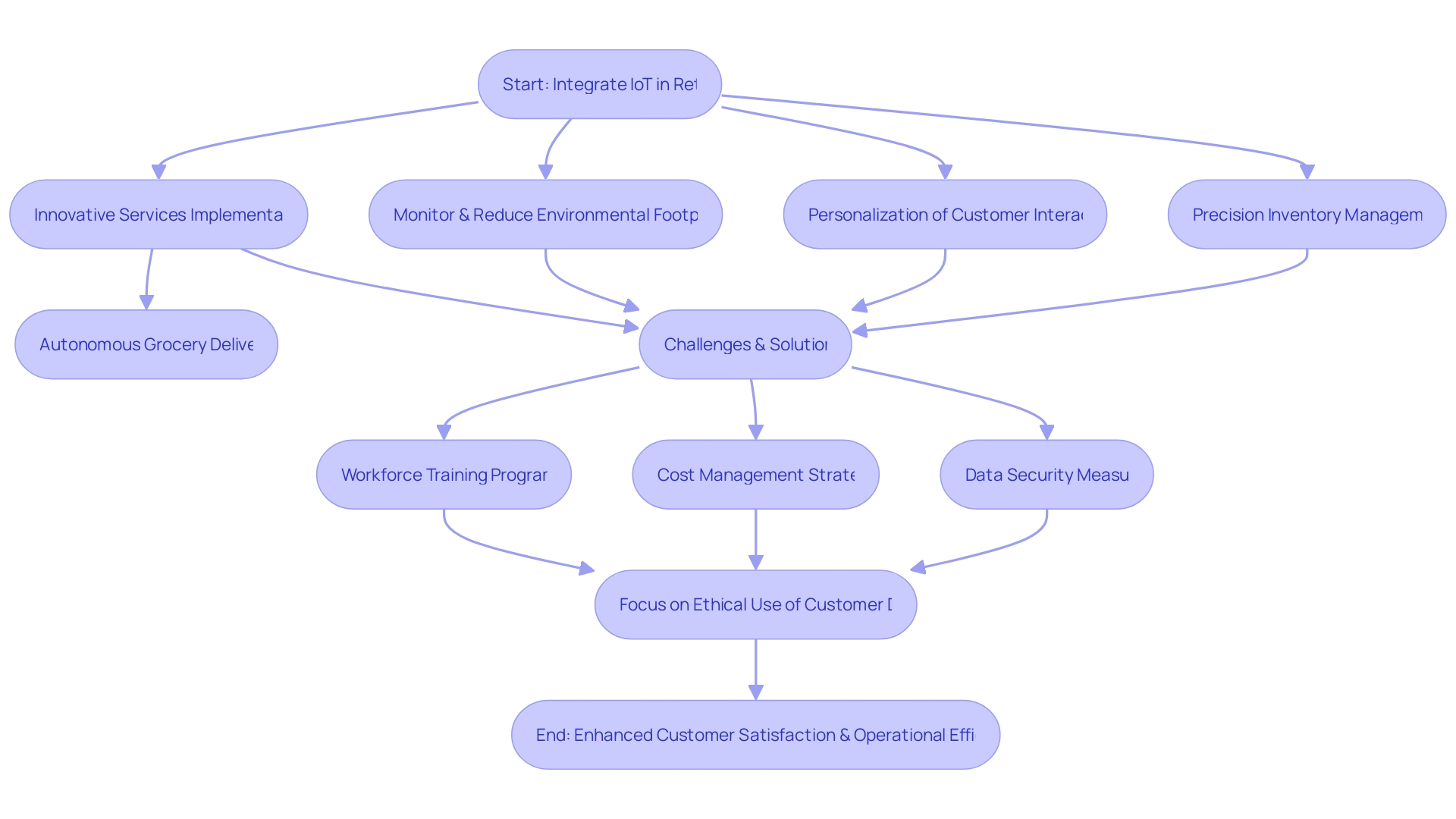Introduction
The grocery retail sector is undergoing a transformative shift with the integration of IoT technologies. This article explores the various key technologies, such as IoT devices, robotics, AI, and inventory management systems, that are revolutionizing the industry.
From enhancing inventory accuracy to optimizing supply chain capabilities, these technologies are reshaping the traditional grocery shopping paradigm and promising a future of convenience and technological sophistication. Additionally, the article discusses the benefits of Grocery Automation Software (GAS) and the role of Artificial Intelligence (AI) in grocery automation. Through case studies and real-world examples, it highlights how these technologies are streamlining operations, improving customer satisfaction, and paving the way for a more efficient and personalized retail industry.
The Need for Automation in Grocery Retail
The grocery retail sector is witnessing a transformative shift with the integration of IoT technologies. These advancements offer retailers opportunities to fine-tune their operations and enhance the shopping experience, creating a futuristic retail landscape where data and technology converge to meet consumer demands.
From the precision of inventory management to the personalization of customer interaction, It is setting new standards for efficiency and customer satisfaction. The sustainability aspect is also being addressed as retailers leverage IoT to monitor and reduce their environmental footprint, emphasizing the ethical use of customer data and transparent data practices.
IoT's potential in smart retail is underscored by innovative examples like Whole Foods' Amazon One service, which allows payment with a simple scan of the palm, and Co-op's partnership with Starship Technologies, which has expanded autonomous grocery delivery services. Meanwhile, Crew Clothing's adoption of Workday Financial Management reflects the broader need for data integration and visibility across retail operations. As the retail landscape evolves with emerging technologies, the challenges of data security, implementation costs, and workforce training persist. These hurdles must be navigated to unlock the full promise of IoT in smart retail, which, according to Lindsey Mazza of Capgemini Group, reaches its highest potential when retailers understand and act on consumer motivations.

Key Technologies in Grocery Automation
In the transformative landscape of grocery retail, the integration of IoT devices, robotics, AI, and inventory management systems is not just a trend but a strategic imperative. These technologies collectively foster a seamless supply chain, enhance inventory accuracy, and facilitate the automation of tasks such as order picking and delivery.
Take, for example, a groundbreaking startup that leverages sensor technologies and AI for real-time inventory tracking and quality control. By employing machine learning and computer vision, they have significantly improved packaging efficiency, minimizing waste and expediting the process.
Such innovations are reshaping the traditional grocery shopping paradigm, promising a future of convenience and technological sophistication. Retailers are recognizing the value of AI, with 85% experimenting with new technologies to refine customer experiences and 35% utilizing AI to better understand customer data.
The potential impact is immense, with generative AI poised to contribute up to $4.4 trillion annually to the global economy. As AI optimizes supply chain capabilities, it simultaneously enhances customer satisfaction, an invaluable asset in the competitive retail arena. The introduction of checkout-free stores, like Amazon Fresh's upcoming Moorgate location, further illustrates the industry's shift towards autonomous technology. In addition, the John Lewis Partnership's expanded collaboration with Google Cloud leverages advanced AI and ML to empower their workforce and tailor customer experiences. These developments exemplify the pervasive influence of IoT and AI in retail, paving the way for a more efficient, personalized, and sustainable industry future.
Grocery Automation Software (GAS) and Its Benefits
Integrating Grocery Automation Software (GAS) with IoT devices, robotics, and AI is revolutionizing the retail landscape. This integration is pivotal in enhancing inventory management, order fulfillment, and customer service. For instance, BigBasket's utilization of Amazon SageMaker to train their AI for FMCG product identification exemplifies the transformative impact of such technologies.
By cutting training time by half and reducing costs by 20%, they demonstrate the efficiency gains achievable through automation. Similarly, St. James Winery's move towards automation, driven by growth and labor shortages, resulted in higher margins, showcasing the financial upside of embracing these technologies. In Ireland, the Dublin Town To Go store introduces a frictionless shopping experience with Zippin technology, eliminating checkout lines and enabling quick, hassle-free purchases.
Ocado Retail's innovative recycling program rewards customers for engagement, further illustrating the potential for technology to foster customer loyalty. Real-time tracking tools like AfterShip, Route, and Shipway leverage GPS and RFID to provide customers with transparency and assurance, enhancing the customer experience. With statistics showing that workflow automation can improve business processes by 60% and the market poised to reach $18.45 billion by 2025, the adoption of GAS and related technologies is not just a trend, but a strategic imperative for retailers aiming to stay competitive and meet ever-evolving customer expectations.
Streamlining Operations with Inventory Management Systems (IMS)
Advanced Inventory Management Systems (IMS) are revolutionizing the way grocery stores operate. By leveraging real-time tracking, these systems not only ensure efficient inventory levels but also empower stores with automated replenishment capabilities.
This technology is crucial in reducing food waste—a persistent challenge in the industry. For example, studies show that strategic partnerships and the use of information communication technology in inventory control can account for a 52.8% variation in retail outlet performance.
Integrating these systems has a direct impact on a store's ability to minimize instances where customers face out-of-stock scenarios, thereby optimizing the shopping experience. Coupled with the power of data analytics, IMS can enhance demand forecasting.
This is critical as the IHL Group's research indicates that inventory-related improvements have led to fuller shelves worldwide. However, the rise in theft in North America has resulted in 17.7% more out-of-stocks compared to the previous year.
Thus, the precise forecasting enabled by IMS can mitigate such issues by keeping a closer tab on inventory levels. The importance of IMS is further highlighted by the case of Cycle Néron, where the transition from a cumbersome inventory process to a modern system has streamlined operations. Previously, the store had to close for a day to count inventory, a practice that is becoming obsolete with the advent of sophisticated IMS solutions. Similarly, Local Express clients using kiosk technology report a 25% increase in basket size orders, demonstrating the significant impact of integrating advanced retail systems on sales and customer satisfaction. As retail experiences evolve, with innovations like checkout-free stores in Ireland, it's evident that the right IMS can play a pivotal role in maintaining competitiveness and meeting the dynamic needs of consumers.

The Role of Artificial Intelligence (AI) in Grocery Automation
In the dynamic arena of grocery retail, Artificial Intelligence (AI) is not just a futuristic concept but a tangible tool driving profound changes. Consider Zara's Just-In-Telligent supply chain that epitomizes the seamless integration of AI in retail.
By employing real-time data analytics and AI, Zara ensures inventory optimization and swift responsiveness to market trends, culminating in a remarkable design-to-shelf time of just one week. This strategic deployment of AI has not only elevated customer satisfaction but also secured Zara a competitive edge in global online fashion sales.
On another front, BigBasket, serving a vast customer base of over 10 million, has harnessed Amazon SageMaker for training computer vision models, cutting training time by half and reducing costs by 20%. This innovation addresses the inefficiencies of manual checkouts prevalent in supermarkets, streamlining operational scales and enhancing the purchasing journey.
The grocery sector is also witnessing the rise of AI-driven customer experiences as showcased by Miravia in Spain, a hybrid marketplace that merges shopping with entertainment. Here, consumers interact with influencer-created content and virtual try-on experiences, while sellers enjoy the liberty of crafting personalized stores with direct customer engagement.
AI's impact extends beyond the surface, as Sabine Benoit from the University of Surrey highlights. The synergy of sensors, algorithms, and connectivity components in AI-enabled products can significantly reduce cognitive costs, facilitating in-store navigation and elevating the shopping experience to match the efficiency of digital counterparts like Google Maps. As Lindsey Mazza, Global Retail Lead at Capgemini Group, emphasizes, understanding consumer motivations is crucial for reaching the zenith of retail potential. The rapid AI adoption in the grocery realm is a testament to this, with Ai's potential to personalize shopping and streamline services becoming increasingly evident. According to Statistics Canada, even in its nascent stages, 6.1% of Canadian businesses employed AI in goods production, indicative of Ai's growing role in shaping the future of retail operations.
Case Study: H-E-B's Automated E-Grocery Fulfillment Centers
Through the strategic deployment of sensor technologies, H-E-B has revolutionized its e-grocery fulfillment operations. The integration of artificial intelligence facilitates the seamless tracking of inventory levels and expiration dates, ensuring that products are fresh and available.
The use of machine learning and computer vision technologies has automated complex inventory management and quality control processes. Additionally, sophisticated algorithms have been developed for sensor fusion, which has significantly improved the packaging process by reducing product damage and waste while also speeding up the time it takes to package goods.
These advancements not only elevate the conventional grocery shopping experience but also pave the way for a future of increased efficiency and convenience. The transformative power of such technologies is evident in the superior order accuracy and reduced delivery times, contributing to a marked enhancement in customer satisfaction. The success of H-E-B's automated fulfillment centers is a testament to the potential of innovative technologies to reshape the retail landscape, offering a more streamlined and technologically advanced shopping experience.
Conclusion
In conclusion, the integration of IoT technologies, robotics, AI, and inventory management systems is revolutionizing the grocery retail sector. These advancements are reshaping the shopping experience by enhancing inventory accuracy, optimizing supply chain capabilities, and streamlining operations. Grocery Automation Software (GAS) is a key driver of this transformation.
By integrating with IoT devices, robotics, and AI, GAS enhances inventory management, order fulfillment, and customer service while improving efficiency and reducing costs. Its adoption is essential for retailers to meet customer expectations and remain competitive. Advanced Inventory Management Systems (IMS) leverage real-time tracking and data analytics to ensure efficient inventory levels and automated replenishment.
This reduces food waste and improves the overall shopping experience by minimizing out-of-stock scenarios. Artificial Intelligence (AI) plays a crucial role in grocery automation. It enables real-time data analytics, inventory optimization, personalized customer experiences, and responsiveness to market trends.
Retailers like Zara and BigBasket have successfully utilized AI to enhance their supply chains, streamline operations, and reduce costs. H-E-B's automated e-grocery fulfillment centers serve as a prime example of the transformative power of these technologies. Through sensor technologies and AI deployment, H-E-B has improved inventory tracking, quality control processes, packaging efficiency, order accuracy, and delivery times.
Overall, these technologies promise a future of convenience, efficiency, personalization, and sustainability in the grocery retail industry. To stay competitive and meet evolving customer expectations, retailers must embrace these transformative technologies. The potential for innovation in this sector is immense as technology continues to reshape the retail landscape towards a more efficient and technologically advanced shopping experience.





